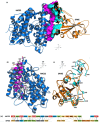Peptide-Based Inhibitors of Protein-Protein Interactions (PPIs): A Case Study on the Interaction Between SARS-CoV-2 Spike Protein and Human Angiotensin-Converting Enzyme 2 (hACE2)
- PMID: 39457672
- PMCID: PMC11504900
- DOI: 10.3390/biomedicines12102361
Peptide-Based Inhibitors of Protein-Protein Interactions (PPIs): A Case Study on the Interaction Between SARS-CoV-2 Spike Protein and Human Angiotensin-Converting Enzyme 2 (hACE2)
Abstract
Protein-protein interactions (PPIs) are fundamental to many critical biological processes and are crucial in mediating essential cellular functions across diverse organisms, including bacteria, parasites, and viruses. A notable example is the interaction between the SARS-CoV-2 spike (S) protein and the human angiotensin-converting enzyme 2 (hACE2), which initiates a series of events leading to viral replication. Interrupting this interaction offers a promising strategy for blocking or significantly reducing infection, highlighting its potential as a target for anti-SARS-CoV-2 therapies. This review focuses on the hACE2 and SARS-CoV-2 spike protein interaction, exemplifying the latest advancements in peptide-based strategies for developing PPI inhibitors. We discuss various approaches for creating peptide-based inhibitors that target this critical interaction, aiming to provide potential treatments for COVID-19.
Keywords: ACE2; COVID-19; SARS-CoV-2; angiotensin-converting enzyme 2; coronavirus; drug design; inhibitors of protein–protein interactions; peptides.
Conflict of interest statement
The authors declare no conflicts of interest.
Figures

References
-
- Cabri W., Cantelmi P., Corbisiero D., Fantoni T., Ferrazzano L., Martelli G., Mattellone A., Tolomelli A. Therapeutic Peptides Targeting PPI in Clinical Development: Overview, Mechanism of Action and Perspectives. Front. Mol. Biosci. 2021;8:697586. doi: 10.3389/fmolb.2021.697586. - DOI - PMC - PubMed
Publication types
Grants and funding
LinkOut - more resources
Full Text Sources
Miscellaneous

